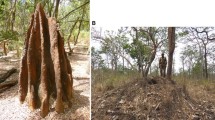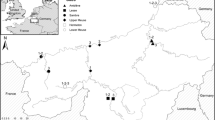Abstract
Fine-scale spatial heterogeneity influences biodiversity and ecosystem productivity at many scales. In savanna systems, Macrotermes termites, through forming spatially explicit mounds with unique woody plant assemblages, emerge as important sources of such heterogeneity. Despite a growing consensus regarding the importance of functional diversity (FD) to ecosystem processes, no study has quantified how termite mounds affect woody plant FD. We address whether termite mounds alter the distribution of functional traits, and increase FD of woody plant communities within Africa’s largest savanna woodland, the 2.7 million km2 miombo system. Using plant traits that change according to soil resources (for example, water and nutrients), and disturbance (for example, fire and elephant herbivory), we identified response functional groups and compared relative representation of these groups between mound and matrix habitats. We also asked whether mound and matrix habitats differed in their contribution to FD within the system. Although species representing most functional groups were found in both mound and matrix habitats, relative abundance of functional groups differed between mound and matrix. Mound plant assemblages had greater response diversity to soil resources than matrix plots, but there was no difference in response diversity to disturbance. High trait values on mounds included tree height, leaf nitrogen, phosphorus, and palatability. Species with root ectomycorrhizae dominated the matrix. In conclusion, these small patches of nutrient-enriched substrate emerge as drivers of FD in above-ground woody plant communities.



Similar content being viewed by others
References
Arita HA. 1993. Conservation biology of the cave bats of Mexico. J Mammal 74:693–702.
Ayotte JB, Parker KL, Arocena JM, Gillingham MP. 2006. Chemical composition of lick soils: functions of soil ingestion by four ungulate species. J Mammal 87:878–88.
Baraloto C, Hérault B, Paine CET, Massot H, Blanc L, Bonal D, Molino J-F, Nicolini EA, Sabatier D. 2012. Contrasting taxonomic and functional responses of a tropical tree community to selective logging. J Appl Ecol 49:861–70.
Benjamini Y, Yekutieli D. 2001. The control of the false discovery rate in multiple testing under dependency. Ann Stat 29:1165–88.
Chapin FS. 2003. Effects of plant traits on ecosystem and regional processes: a conceptual framework for predicting the consequences of global change. Ann Bot 91:455–63.
Clarke KR, Warwick RM. 1994. Change in marine communities: an approach to statistical analysis and interpretation. Natural Environment Research Council. Plymouth: Hutchings & Mason Ltd. 144 pp.
Coates Palgrave K, Coates Palgrave M. 2002. Palgrave’s trees of southern Africa. Cape Town: Struik Publishers.
Cornelissen JHC, Lavorel S, Garnier E, Díaz S, Buchmann N, Gurvich DE, Reich PB, ter Steege H, Morgan HD, Van Der Heijden MGA, Pausas JG, Poorter H. 2003. A handbook of protocols for standardised and easy measurement of plant functional traits worldwide. Aust J Bot 51:335–80.
Cornwell WK, Ackerly DD. 2009. Community assembly and shifts in plant trait distributions across an environmental gradient in coastal California. Ecol Monogr 79:109–26.
Cornwell WK, Ackerly DD. 2010. A link between plant traits and abundance: evidence from coastal California woody plants. J Ecol 98:814–21.
Cortez J, Garnier E, Pérez-Harguindeguy N, Debussche M, Gillon D. 2007. Plant traits, litter quality and decomposition in a Mediterranean old-field succession. Plant Soil 296:19–34.
Dean WRJ, Milton SJ, Jeltsch F. 1999. Large trees, fertile islands, and birds in arid savanna. J Arid Environ 41:61–78.
Díaz S, Cabido M, Zak M, Martínez Carretero E, Aranibar J. 1999. Plant functional traits, ecosystem structure and land-use history along a climatic gradient in central-western Argentina. J Veg Sci 10:651–60.
Díaz S, Cabido M. 2001. Vive la différence: plant functional diversity matters to ecosystem processes. Trends Ecol Evol 16:646–55.
Ellsworth JW, McComb BC. 2003. Potential effects of passenger pigeon flocks on the structure and composition of presettlement forests of eastern North America. Conserv Biol 17:1548–58.
Elmqvist T, Folke C, Nyström M, Peterson G, Bengtsson J, Walker B, Norberg J. 2003. Response diversity, ecosystem change, and resilience. Front Ecol Environ 1:488–94.
Ernst W. 1975. Variation in the mineral contents of leaves of trees in miombo woodland in south central Africa. J Ecol 63:801–7.
Ettema CH, Wardle DA. 2002. Spatial soil ecology. Trends Ecol Evol 17:177–83.
FAO/IIASA/ISRIC/ISS-CAS/JRC. 2012. Harmonized World Soil Database (version 1.2). FAO Rome, Italy and IIASA, Laxenburg, Austria. http://webarchive.iiasa.ac.at/Research/LUC/External-World-soil-database/HTML/. Accessed 3 Nov 2012.
Fleming PA, Loveridge JP. 2003. Miombo woodland termite mounds: resource islands for small vertebrates? J Zool 259:161–8.
Frost P. 1996. The ecology of miombo woodlands. In: Campbell B, Ed. The miombo in transition: woodlands and welfare in Africa. Bogor: Center for International Forestry Research (CIFOR). p 11–58.
Gotelli NJ, Rohde K. 2002. Co-occurrence of ectoparasites of marine fishes: a null model analysis. Ecol Lett 5:86–94.
Higgins SI, Bond WJ, February EC, Bronn A, Euston-Brown DIW, Enslin B, Govender N, Rademan L, O’ Regan S, Potgieter ALF, Scheiter S, Sowry R, Trollope L, Trollope WSW. 2007. Effects of four decades of fire manipulation on woody vegetation structure in savanna. Ecology 88:1119–25.
Holdo RM, McDowell LR. 2004. Termite mounds as nutrient-rich food patches for elephants. Biotropica 36:231–9.
Joseph GS, Cumming GS, Cumming DHM, Mahlangu Z, Altwegg R, Seymour CL. 2011. Large termitaria act as refugia for tall trees, deadwood and cavity-using birds in a miombo woodland. Landsc Ecol 26:439–48.
Joseph GS, Seymour CL, Cumming GS, Cumming DHM, Mahlangu Z. 2013a. Termite mounds as islands: woody plant assemblages relative to termitarium size and soil properties. J Veg Sci 24:702–11. doi:10.1111/j.1654-1103.2012.01489.x.
Joseph GS, Seymour CL, Cumming GS, Mahlangu Z, Cumming DHM. 2013b. Escaping the flames: large termitaria as refugia from fire in miombo woodland. Landsc Ecol 28:1505–16. doi:10.1007/s10980-013-9897-6.
Keddy PA. 1992. Assembly and response rules: two goals for predictive community ecology. J Veg Sci 3:157–64.
Laliberté E, Legendre P. 2010. A distance-based framework for measuring functional diversity from multiple traits. Ecology 91:299–305.
Laliberté E, Shipley B. 2011. FD: measuring functional diversity from multiple traits, and other tools for functional ecology. R package 1.0–11.
Lavorel S, Garnier E. 2002. Predicting changes in community composition and ecosystem functioning from plant traits. Funct Ecol 16:545–56.
Levick SR, Asner GP, Kennedy-Bowdoin T, Knapp DE. 2010. The spatial extent of termite influences on herbivore browsing in an African savanna. Biol Conserv 143:2462–7.
Lineham S. 1965. Rainfall in Rhodesia. In: Collins MO, Ed. Rhodesia: its natural resources and economic development. p. 26–7.
Loveridge JP, Moe SR. 2004. Termitaria as browsing hotspots for African megaherbivores in miombo woodland. J Trop Ecol 20:337–43.
Malaisse F. 1978. High termitaria. In: Werger MJA, Ed. Biogeography and ecology of southern Africa. The Hague: Junk. p 1279–300.
Mapaure IN, Campbell BM. 2002. Changes in miombo woodland cover in and around Sengwa Wildlife Research Area, Zimbabwe, in relation to elephants and fire. Afr J Ecol 40:212–19.
Mason NWH, Peltzer DA, Richardson SJ, Bellingham PJ, Allen RB. 2010. Stand development moderates effects of ungulate exclusion on foliar traits in the forests of New Zealand. J Ecol 98:1422–33.
Oksanen J, Blanchet FG, Roeland Kindt, Legendre P, Minchin PR, O’Hara RB, Simpson GL, Solymos P, Stevens MHH, Wagner H. 2013. Vegan: Community Ecology Package. R package version 2.0-7. http://cran.r-project.org/package=vegan. Accessed 5 May 2013.
Petchey OL, Gaston KJ. 2006. Functional diversity: back to basics and looking forward. Ecol Lett 9:741–58.
Pickett STA, Cadenasso ML. 1995. Landscape ecology: spatial heterogeneity in ecological systems. Science 269:331–4.
Podani J, Schmera D. 2006. On dendrogram-based measures of functional diversity. Oikos 115:179–85.
Podani J. 1999. Extending gower’s general coefficient of similarity to ordinal characters. Taxon 48:331–40.
Podgaiski LR, Joner F, Lavorel S, Moretti M, Ibanez S, Mendonça MDS, Pillar VD. 2013. Spider trait assembly patterns and resilience under fire-induced vegetation change in South Brazilian grasslands. PloS one 8:e60207. http://www.pubmedcentral.nih.gov/articlerender.fcgi?artid=3610671&tool=pmcentrez&rendertype=abstract. Accessed 20 May 2013.
Pringle RM, Doak DF, Brody AK, Jocqué R, Palmer TM. 2010. Spatial pattern enhances ecosystem functioning in an African savanna. PLoS Biol 8:e1000377.
R Development Core Team. 2011. R: a language and environment for statistical computing. R Foundation for Statistical Computing, Vienna, Austria. ISBN 3-900051-07-0, http://www.R-project.org/. Accessed 4 March 2011.
Richardson-Kageler SJ. 2004. Effects of large herbivore browsing on the functional groups of woody plants in a southern African savanna. Biodivers Conserv 13:2145–63.
SADC Food Security Programme. 1991. Draft soil map of Zimbabwe http://eusoils.jrc.ec.europa.eu/esdb_archive/eudasm/africa/maps/afr_zw2015_so.html. Accessed 20 June 2012.
Sankaran M, Hanan NP, Scholes RJ, Ratnam J, Augustine DJ, Cade BS, Gignoux J, Higgins SI, Le Roux X, Ludwig F, Ardo J, Banyikwa F, Bronn A, Bucini G, Caylor KK, Coughenour MB, Diouf A, Ekaya W, Feral CJ, February EC, Frost PGH, Hiernaux P, Worden J, Zambatis N. 2005. Determinants of woody cover in African savannas. Nature 438:8–11.
Schenk HJ, Jackson RB. 2002. The global biogeography of roots. Ecol Monogr 72:311–28.
Schwartz MW, Brigham CA, Hoeksema JD, Lyons KG, Mills MH, van Mantgem PJ. 2000. Linking biodiversity to ecosystem function: implications for conservation ecology. Oecologia 122:297–305.
Seymour CL, Milewski AV, Mills AJ, Joseph GS, Cumming GS, Cumming DHM, Mahlangu Z. 2014. Do the large termite mounds of Macrotermes concentrate micronutrients in addition to macronutrients in nutrient-poor African savannas? Soil Biol Biochem 68:95–105.
Sileshi GW, Arshad MA, Konate S, Nkunika POY. 2010. Termite-induced heterogeneity in African savanna vegetation: mechanisms and patterns. J Veg Sci 21:923–37.
Suding KN, Lavorel S, Chapin FS, Cornelissen JHC, Díaz S, Garnier E, Goldberg D, Hooper DU, Jackson ST, Navas M-L. 2008. Scaling environmental change through the community-level: a trait-based response-and-effect framework for plants. Glob Change Biol 14:1125–40.
Tilman D. 2001. Functional Diversity. In: Levin SA, Ed. Encyclopedia of Biodiversity, Vol. 3. San Diego, CA: Academic Press. p 109–21.
Torrance JD. 1965. The temperature of Rhodesia. In: Collins MO, editor. Rhodesia: its natural resources and economic development. pp 28–9.
Van der Plas F, Howison R, Reinders J, Fokkema W, Olff H. 2013. Functional traits of trees on and off termite mounds: understanding the origin of biotically-driven heterogeneity in savannas. Bruun HH, editor. J Veg Sci 24:227–38.
Walker BH. 1980. A review of browse and its role in livestock production in southern African savannas. Proc Grassland Soc of southern Africa 11:125–130.
Walker B, Kinzig A, Langridge J. 1999. Plant attribute diversity, resilience, and ecosystem function: The nature and significance of dominant and minor species. Ecosystems 2:95–113.
Webb CO, Ackerly DD, McPeek MA, Donoghue MJ. 2002. Phylogenies and community ecology. Ann Rev Ecol Syst 33:475–505.
White F. 1983. The vegetation of Africa: a descriptive memoir to accompany the UNESCO/AETFAT/UNSO vegetation map of Africa, p. 356. UNESCO, Paris.
Young TP, Patridge N, Macrae A. 1995. Long-term glades in acacia bushland and their edge effects in Laikipia, Kenya. Ecol Appl 5:97–108.
Acknowledgments
This research was funded by an NRF-SADC collaborative grant and the DST/NRF Centre of Excellence at the University of Cape Town. The Director General of the Zimbabwe National Parks and Wildlife Management Authority (ZNPWMA) granted permission to carry out this research under the auspices of a memorandum of understanding between the ZNPWMA and the Tropical Resource Ecology Programme (TREP) at the University of Zimbabwe. Chris Chapano and Anthony Mapaura, and Christien Bredenkamp of the National Herbaria of Harare and Pretoria, respectively, offered assistance and guidance in building a database of functional traits.
Author information
Authors and Affiliations
Corresponding author
Additional information
Author's Contribution
GSJ, GSC conceived of the study; GSJ, CLS, ZM designed the study and gathered data; GSJ, CLS carried out analyses; GSJ, CLS, GSC, DHMC wrote the paper
Electronic supplementary material
Below is the link to the electronic supplementary material.
Rights and permissions
About this article
Cite this article
Joseph, G.S., Seymour, C.L., Cumming, G.S. et al. Termite Mounds Increase Functional Diversity of Woody Plants in African Savannas. Ecosystems 17, 808–819 (2014). https://doi.org/10.1007/s10021-014-9761-9
Received:
Accepted:
Published:
Issue Date:
DOI: https://doi.org/10.1007/s10021-014-9761-9




